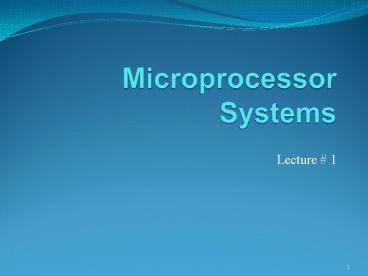Microprocessor Systems PowerPoint PPT Presentation
1 / 34
Title: Microprocessor Systems
1
Microprocessor Systems
- Lecture 1
2
Course Website and group
- www.uettaxila.edu.pk/cms/mps
- http//groups.yahoo.com/group/mps_07
3
Marks Distribution
- Final paper 60 marks
- Mid 20 marks
- Internal 20 marks
- Quizzes
- Assignment
- Project
- Report
- Deliverable
- Presentation
4
Books
- Course Book
- The Intel microprocessors 8086/8088, 80186/80188
80286/80288, 80386, 80486, Pentium, Pentium Pro
Processor - Author Barry B. Brey
- 7th Edition
5
Course Contents
- Introduction to Microprocessor
- Microprocessor Programming model
- Address Modes and Assembly Language instructions
- Microprocessor Hardware Specification
- Input /Output Interfacing
- Interrupts
- Direct Memory Access (DMA controller)
- Microcontrollers and Applications
- Programming of Embedded devices
- Microprocessor Designs
- DSP Processors and Applications
6
Abacus
- 3000 BCE, early form of beads on wires, used in
China
7
Chinese Swan Pan
8
Charles Babbage (1791-1871)
9
Charles Babbage (1791-1871)
- Born December 26, 1791
- son of Benjamin Babbage a London banker
- (part of the emerging middle class property,
education, wealth, and status) - Trinity College, Cambridge MA, 1817
- with John Herschel and George Peacock,
produced a translation of LaCroixs calculus text.
10
Science Museum Recreation 1991 (Doron Swade,
Curator)
11
12
Analytical Engine
13
Herman Hollerith (1860-1929)
14
Smithsonian Exhibit (old)
15
Electronic Numerical Integrator and Computer
- 1st large scale electronic digital computer
- designed and constructed at the Moore School of
Electrical Engineering of the University of
Pennsylvania
16
ENIAC at Moore School, University of Pennsylvania
17
(No Transcript)
18
Early Thoughts about Stored Program Computing
- January 1944 Moore School team thinks of better
ways to do things. - September 1944 John von Neumann visits
- Goldstines meeting at Aberdeen Train Station
- October 1944 Army extends the ENIAC contract to
include research on the EDVAC and the
stored-program concept - Spring 1945 ENIAC working well
- June 1945 First Draft of a Report on the EDVAC
Electronic Discrete Variable Automatic Computer
19
20
21
22
John Mauchly leaning on the UNIVersal Automatic
Computer
23
Assabet Mills, Maynard
24
Microprocessors?
25
The Microprocessor
- The silicon chip that contains the CPU where most
calculations take place - Microprocessors are distinguished by 3
characteristics - Instruction set the set of instructions that the
microprocessor can execute - Bandwidth the number of bits processed in each
instruction - Clock speed (MHz) It determines how many
instructions/second the processor can execute
26
Role of The Microprocessor
- Fetch the Instruction from the memory
- Fetch the operands of the Instruction
- Decode the Instruction
- Execute the Instruction
- Output the results
- CPU continuously does the (Fetch-Decode-Execute)
Cycle
27
What is a Computer?
28
Intel
- Noyce, Moore, and Andrew Grove leave Fairchild
and found Intel in 1968 - focus on random access memory (RAM) chips
- Question if you can put transistors, capacitors,
etc. on a chip, why couldnt you put a central
processor on a chip? - Ted Hoff designs the Intel 4004, the first
microprocessor in 1969
29
The History of Intels Microprocessors
- Intel 4004
- 1971, 4-bit
- Intel 8008
- 1972, 8-bit
- Originally designed for Datapoint Corp. as a CRT
display controller - Intel 8080
- 1974, April - Altair 8800, 1975, MITS( 256 bytes
of Mem, 395) - Apple II -- Steve Jobs and Steve Wozniak 1976,
Apple - Bill Gates and a fellow student BASIC, 1975 --gt
Microsoft - Intel 8086/8088
- 1978, 16 bit 8088, 1979, 8-bit external bus
30
The History of Intels Microprocessors
- IBM PC 1981
- 29,000 Trs
- Intel 80286
- 1982, 16-bit architecture
- 24-bit addressing.
- 16 MB of physical MEM
- 130,000 Trs onto a single chip
- IBM PC/AT in 1984, IBM PS/2 Model 50 and 60
- Intel 80386
- 1985, 32 bits
- 35 MIPS (7 MIPS on the 25 MHz chip)
- memory paging and enhanced I/O permission
features - 4GB programming model
31
The History of Intels Microprocessors
- Intel 80486
- 1989 Spring COMDEX show -gt 1990 June actual
release - 1,200,000 Trs
- 3863878K data and instruction cache, paging and
MMU - Pentium
- 1993
- 110 MIPS on 66 Mhz Chip
- 16 KB on-chip cache and 64 bit data bus
- superscalar technology (two instructions/clock)
- 3.1 million transistors
32
The History of Intels Microprocessors
- Pentium Pro
- 1995, Superscalar(three-way issue)
- 5.5 million Trs in the CPU core 15.5 million
Trs in the secondary cache 8K data, 8K instr
cache - 256 KB SRAM secondary cache
- 133 MHz
- Pentium II
- Pentium Pro 1997
- 233, 266, upto 450 MHz
- 7.5 million Trs in CPU
- 512KB in secondary cache
33
The History of Intels Microprocessors
- Pentium III
- 1999
- Pentium Pro Internet Streaming SIMD Instructions
- 0.25 micron, 9.5 million Trs
- 600 MHz, 550 MHz,...
- 32 K
34
Assignment 1
- Arithmetic in Decimal, Binary, octal and
Hexadecimal number systems - List of Latest available microprocessors from the
leading companies. - Memory
- OS supported
- Bus speed
- Frequency

